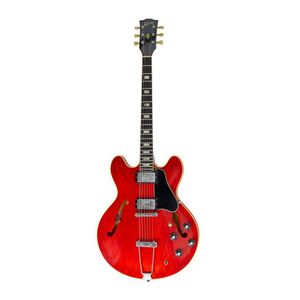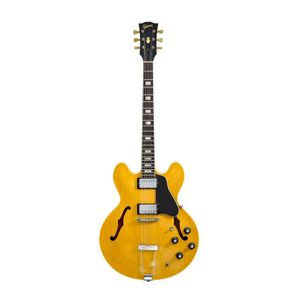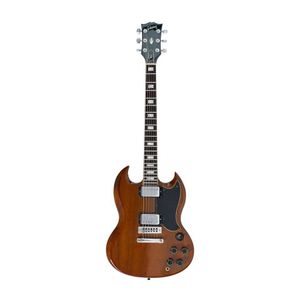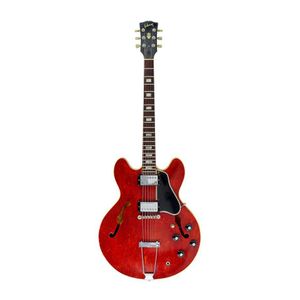1968 Gibson ES-335 Electric Guitar Owned by David Byrne
You must be a subscriber, and be logged in to view price and dealer details.
Subscribe Now to view actual auction price for this item
When you subscribe, you have the option of setting the currency in which to display prices to $Au, $US, $NZ or Stg.
- Mahogany - Mahogany is a dense, close grained red-coloured timber from the West Indies and Central America. It was first imported into Europe in the the early 18th century and its use continued through the 19th century. It was popular for furniture making because of its strength, the wide boards available, the distinctive grain on some boards, termed flame mahogany and the rich warm colour of the timber when it was polished.. The "flame" was produced where a limb grew out from the trunk of the tree, and this timber was usually sliced into veneers for feature panels on doors, backs and cornices.
Some terms used to describe mahogany relate to the country from which it originally came, such as "Cuban" mahogany, "Honduras" mahogany etc. However unless the wood has been tested the names assigned are more a selling feature, rather than a true indication of the timber's origin. - Rosewood - A dense timber that varies in shade to very light brown to almost black. When rosewood is cut and sanded the colour of the timber will turn black, and after polishing and exposure to daylight, the surface will gradually lighten over time to light brown with black streaks.
The name comes from the odour emanating from the timber when it is planed, sanded or cut.
Rosewood was very popular for use in Victorian furniture in the second half of the 19th century, and at that time most of the rosewood was imported from Brazil. However it also grows in India and Indonesia.
It is used in the sold for chairs and table legs, but for carcase furniture such as side cabinets and bookcases, and for table tops it is always used as a veneer. - Mother-Of-Pearl - Mother-of-pearl, technical name "nacre", is the inner layer of a sea shell. The iridescent colours and strength of this material were widely used in the nineteenth century as an inlay in jewellery, furniture, (especially papier mache furniture) and musical instruments.
In the early 1900s it was used to make pearl buttons. Mother-of-pearl is a soft material that is easily cut or engraved.
Nowadays it is a by-product of the oyster, freshwater pearl mussel and abalone industries. - Maple - Maple, native to North America, is a dense heavy timber from light to yellow-brown in colour. It has very little distincive graining unless it is one of the variants such as birds-eye maple or burr maple, so was not used extensively for furniture in 18th and 19th century, where cabinetmakers and designers preferred timbers with more distinctive features such as mahogany, walnut, rosewood and oak.
Birds-eye maple has a seres of small spots linked by undulating lines in the grain, is highly sough and is used as a decorative veneer. Burr maple has larger and irregular grain swirls than birds-eye maple.
This item has been included into following indexes:
Visually similar items

A Gibson ES-335 'Cherry' electric guitar, 1972, American made, serial number 752661 stamped to rear of headstock, 'Norlin' white rectangular printed maker's label to interior inscribed with model and serial numbers, six nickel 'Kluson Deluxe' machine heads

A Gibson ES-340 Blonde electric guitar with OHSC, 1969, American made, serial number 563266 stamped to rear of headstock, 'Orange Oval' printed maker's label to interior inscribed with model and serial numbers, six nickel 'Kluson Deluxe' machine heads, bou

An Ernie Ball Music Man Luke electric guitar with EMG pickups, 2004, American made, serial number G24062, high gloss polyester 'Luke Candy Red' finish, solid Alder body, chrome plated floating vintage tremolo, 6 adjustable steel saddles, bolt on select map

A Gibson SG electric guitar, 1972, American made, serial number 700432 stamped to rear of headstock, six chrome plated machine heads, mahogany body and neck with walnut lacquer finish, East Indian rosewood fretboard with mother-of-pearl block inlays, mothe
